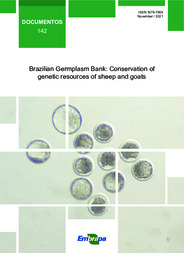Brazilian Germplasm Bank: conservation of genetic resources of sheep and goats.
Brazilian Germplasm Bank: conservation of genetic resources of sheep and goats.
Autoria: FONSECA, J. F. da; SILVA, K. de M.
Resumo: Brazil is known for its enormous natural animal resources, typically associated with a large diversion of biomes. Although they do not originate in the country, the sheep and goats that were incorporated by settlers after the discovery became the so-called locally adapted animals. This adaptation obeyed the environmental challenges imposed, being more severe in the semi-arid zone - Caatinga biome. Similar to the African savannah, important and unique genotypes of small ruminants live in the Caatinga. Most of them are under some degree of extinction risk mainly because there is no economic interest and/or indiscriminate reproduction with commercially exploited sheep and goats around the world, such as Dorper and Boer, respectively. These specimens were included in the Brazilian Germoplasma Bank. Many genetic conservation strategies for these offspring include maintaining conservation units for a few dozen females and a few males, DNA, semen and embryos. The embryo biobank is the most viable and fastest strategy for preserving genuine specimens and rebuilding the herd, being the best option for preserving mammals in a situation of extinction. Initially, the Brazilian Bank of Embryos of Sheep and Goats was supported by the surgical recovery of embryos. Over time, after great Brazilian efforts and increases in the efficiency of non-surgical embryo recovery (NSER), the embryo bank became more pronouncedly composed of embryos of NSER origin. This document will take the reader through the history of the Brazilian Embryo Bank of Sheep and Goats with important information about the breeds included and techniques for preserving them
Ano de publicação: 2021
Tipo de publicação: Folhetos
Unidade: Embrapa Caprinos e Ovinos
Palavras-chave: Brazil, Conservation programs, Genetic resources, Goats, Sheep, Small ruminants
Observações
1 - Por padrão são exibidas publicações dos últimos 20 anos. Para encontrar publicações mais antigas, configure o filtro ano de publicação, colocando o ano a partir do qual você deseja encontrar publicações. O filtro está na coluna da esquerda na busca acima.
2 - Para ler algumas publicações da Embrapa (apenas as que estão em formato ePub), é necessário ter, no celular ou computador, um desses softwares gratuitos. Sistemas Android: Google Play Livros; IOS: iBooks; Windows e Linux: software Calibre.
Acesse outras publicações
Acesse a Base de Dados da Pesquisa Agropecuária (BDPA) para consultar o acervo completo das bibliotecas da Embrapa.

